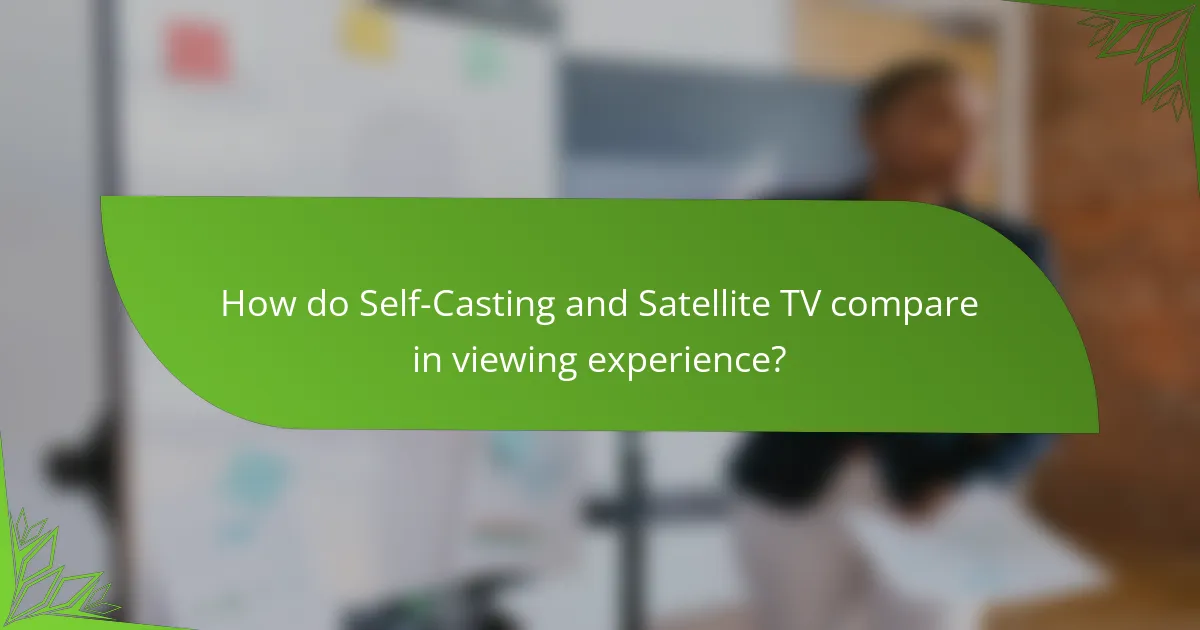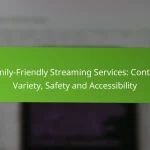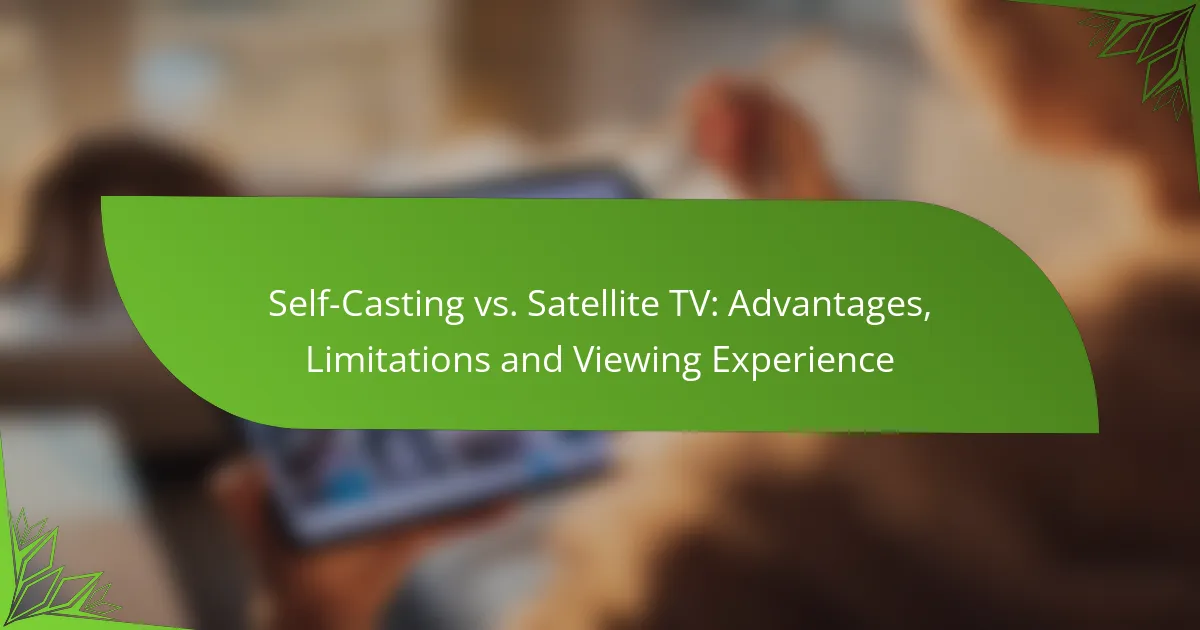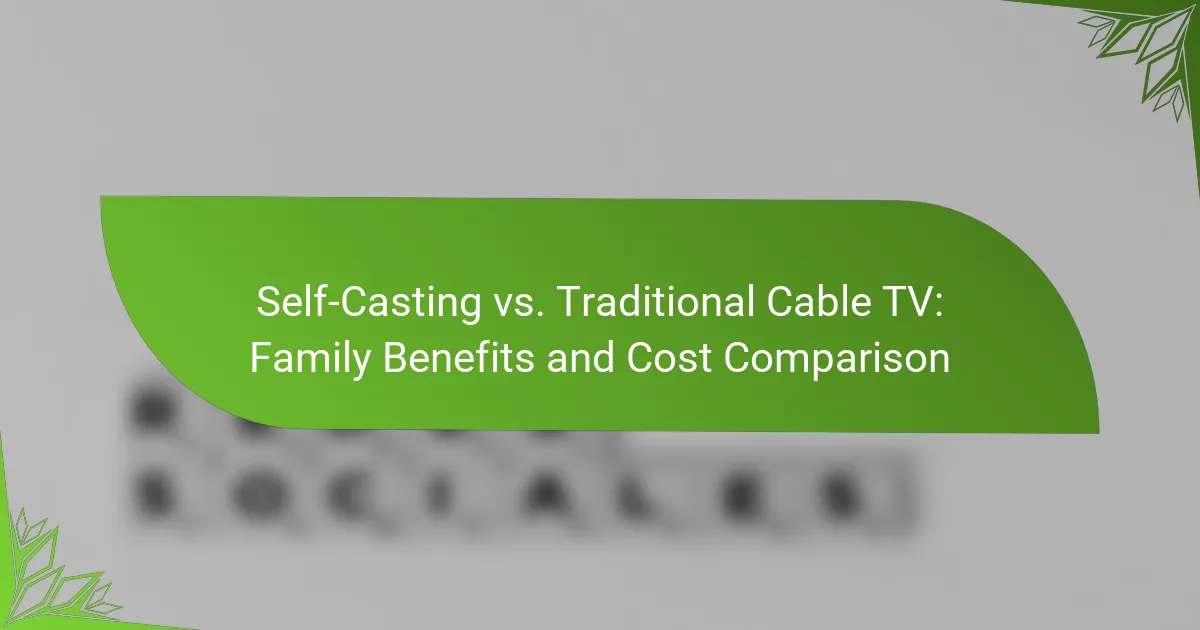In the evolving landscape of home entertainment, self-casting and satellite TV present distinct advantages and limitations that shape the viewing experience. Self-casting allows for cost-effective streaming and access to diverse content across multiple devices, while satellite TV boasts a wide range of channels and reliable service, particularly in remote areas. Understanding these differences can help viewers make informed choices about their entertainment options.

What are the advantages of Self-Casting in the US?
Self-casting offers several advantages in the US, including cost savings, diverse content options, and the ability to watch on various devices. This method allows users to stream content directly from their devices without relying on traditional cable subscriptions.
Cost-effectiveness
Self-casting can significantly reduce monthly entertainment expenses compared to satellite TV. Subscriptions to streaming services often range from $5 to $15 per month, while satellite packages can exceed $100 monthly. This difference makes self-casting a more budget-friendly option for many households.
Additionally, many streaming platforms offer free content or ad-supported options, further lowering costs. Users can choose to pay only for the services that align with their viewing preferences, avoiding unnecessary fees.
Flexibility in content selection
Self-casting provides users with the flexibility to select content that suits their interests. Unlike satellite TV, which often bundles channels, streaming services allow viewers to pick and choose specific shows, movies, or genres. This customization enhances the viewing experience.
Moreover, many platforms offer on-demand access to content, enabling users to watch what they want, when they want. This flexibility is particularly beneficial for those with varying schedules or preferences.
Accessibility on multiple devices
Self-casting allows viewers to access content on a wide range of devices, including smartphones, tablets, smart TVs, and computers. This multi-device compatibility means that users can enjoy their favorite shows anywhere, whether at home or on the go.
Most streaming services support casting to larger screens, making it easy to transition from a mobile device to a TV. This versatility enhances the overall viewing experience, accommodating different environments and preferences.
Customization of viewing experience
With self-casting, users can tailor their viewing experience to their liking. This includes options for subtitles, audio settings, and personalized recommendations based on viewing history. Such features allow for a more enjoyable and user-centric experience.
Additionally, many platforms enable users to create watchlists and set reminders for upcoming shows, ensuring that they never miss their favorite content. This level of customization is often lacking in traditional satellite TV services.

What are the limitations of Self-Casting?
Self-casting, while convenient, has several limitations that can affect the overall viewing experience. Key issues include internet dependency, potential buffering problems, and limited channel availability.
Internet dependency
Self-casting relies heavily on a stable internet connection. If your internet service is slow or unreliable, it can lead to interruptions during streaming, which can be frustrating. Users should ensure they have a broadband connection with sufficient speed, typically at least 25 Mbps for smooth streaming.
Potential buffering issues
Buffering can occur when the data being streamed cannot keep up with the playback. This can be caused by network congestion, insufficient bandwidth, or even device limitations. To minimize buffering, consider using a wired connection instead of Wi-Fi and closing other applications that may consume bandwidth.
Limited channel availability
Self-casting may not provide access to all the channels available through traditional satellite TV. Many streaming services focus on popular networks, which can leave out niche channels or local broadcasts. Users should check the specific offerings of their self-casting service to ensure it meets their viewing preferences.

What are the advantages of Satellite TV in the US?
Satellite TV offers several advantages in the US, including a broad range of channels, superior signal quality, and dependable service in remote locations. These benefits make it a popular choice for many households seeking diverse entertainment options.
Wide channel selection
One of the primary advantages of satellite TV is its extensive channel selection. Subscribers can access hundreds of channels, including premium networks, international programming, and niche content that may not be available through cable providers.
This wide variety allows viewers to tailor their entertainment experience to their preferences, whether they are interested in sports, movies, or specialized shows. Many satellite packages also include on-demand options, enhancing the viewing experience further.
High-quality signal
Satellite TV typically provides a high-quality signal that is less susceptible to interference compared to cable or streaming services. This means viewers can enjoy clearer picture quality and better sound, even during adverse weather conditions.
Moreover, many satellite providers now offer HD and 4K channels, allowing for an enhanced viewing experience that captures finer details and vibrant colors, making it ideal for movie nights or sports events.
Reliability in remote areas
For those living in rural or remote areas of the US, satellite TV is often the most reliable option for television service. Unlike cable, which may not reach all locations, satellite signals can be accessed almost anywhere with a clear view of the sky.
This reliability is crucial for viewers who may not have access to high-speed internet, as satellite TV does not rely on broadband connections. It ensures that users can enjoy consistent entertainment without interruptions, regardless of their geographical location.

What are the limitations of Satellite TV?
Satellite TV has several limitations that can affect the viewing experience, including higher costs, installation challenges, and susceptibility to weather disruptions. Understanding these factors is crucial for potential subscribers.
Higher subscription costs
Satellite TV typically comes with higher subscription fees compared to other services like cable or streaming. Monthly costs can range from around $50 to over $150, depending on the package and channels included. Additionally, many providers require long-term contracts that may include penalties for early cancellation.
When considering satellite TV, it’s important to factor in these ongoing costs along with potential hidden fees for equipment rental or premium channels. Budgeting for these expenses can help avoid surprises later.
Installation requirements
Installing satellite TV often requires professional installation, which can add to the initial setup costs. A satellite dish must be mounted in a location with a clear line of sight to the satellite, which may not always be feasible in urban areas with tall buildings or trees.
Homeowners should also consider the potential need for roof work or additional hardware, which can complicate the installation process. Some providers may offer self-installation kits, but these can be challenging for those unfamiliar with technology.
Weather-related signal disruption
Satellite TV is particularly vulnerable to weather-related disruptions, such as heavy rain, snow, or storms. These conditions can lead to temporary signal loss, resulting in interruptions during viewing. This is known as “rain fade,” and it can vary in severity based on the satellite system used.
To mitigate this issue, subscribers should be aware of their local climate and consider having backup entertainment options available during severe weather. Additionally, regular maintenance of the satellite dish can help ensure optimal performance during adverse conditions.

How do Self-Casting and Satellite TV compare in viewing experience?
Self-casting and satellite TV offer distinct viewing experiences, each with its own advantages and limitations. Self-casting typically provides more flexibility and control over content, while satellite TV often delivers a broader range of channels and stable signal quality.
Content delivery speed
Self-casting generally allows for quicker access to content, as it streams directly from the internet. Users can often start watching shows or movies in just a few seconds, depending on their internet speed. In contrast, satellite TV may have a slight delay due to signal transmission, typically ranging from a few seconds to a minute.
For optimal self-casting performance, a stable broadband connection is essential. Users should aim for speeds of at least 25 Mbps for high-definition streaming to minimize buffering.
Picture quality differences
Picture quality can vary significantly between self-casting and satellite TV. Self-casting services often support high-definition (HD) and even 4K content, depending on the platform and user’s internet capabilities. Satellite TV also offers HD channels, but the quality can be affected by weather conditions, leading to potential disruptions.
When choosing between the two, consider the type of content you watch. For example, sports and action films benefit from higher resolutions and frame rates available through self-casting, while satellite TV may suffice for standard viewing.
User interface and navigation
User interface and navigation differ greatly between self-casting and satellite TV. Self-casting platforms typically feature intuitive interfaces that allow users to search and browse content easily, often with personalized recommendations. This can enhance the overall viewing experience by making it simpler to find desired shows or movies.
On the other hand, satellite TV interfaces may be less user-friendly, with traditional channel listings and remote controls. While some satellite providers have improved their navigation systems, it may still feel cumbersome compared to the streamlined experience of self-casting.

What factors should be considered when choosing between Self-Casting and Satellite TV?
When deciding between self-casting and satellite TV, consider your budget, viewing habits, and the overall experience each option provides. Each choice has distinct advantages and limitations that can significantly impact your entertainment experience.
Budget constraints
Budget is a crucial factor when choosing between self-casting and satellite TV. Self-casting typically involves lower upfront costs, as it often requires only a compatible device and internet connection, while satellite TV may involve installation fees and equipment rentals.
Monthly subscription fees also vary. Satellite TV packages can range from moderate to high costs, depending on the channels and services included. In contrast, self-casting services often have lower monthly fees or even free options, making them more budget-friendly for many users.
Viewing habits
Your viewing habits play a significant role in determining which option is best for you. If you prefer on-demand content and flexibility, self-casting may be more suitable, as it allows you to stream shows and movies whenever you want.
On the other hand, if you enjoy live sports or specific channels that are only available through satellite TV, this option may be more appealing. Consider how often you watch live broadcasts versus on-demand content to make an informed choice.










